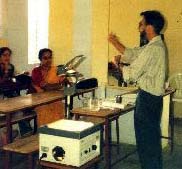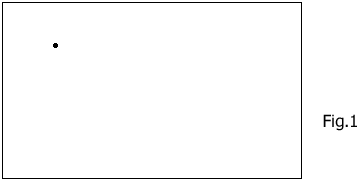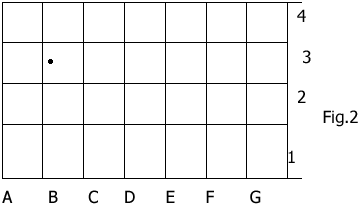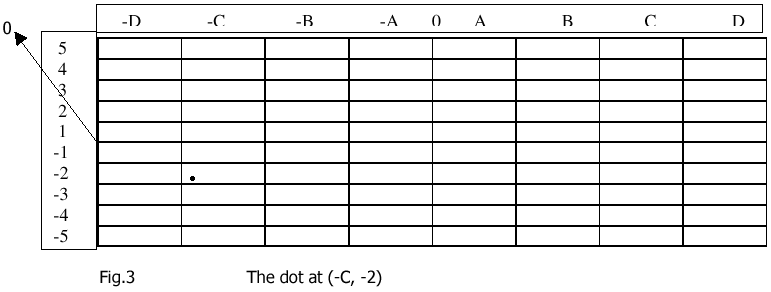 Teacher Feature...
Teacher Feature...
Teaching Graph from the Grassroots
by P R Guruuprasad
Mathematics is generally felt to be a difficult school subject in South Asia. The center of gravity of the problem lies in the teaching learning interaction within the classroom.
An important objective of teaching the concept is to enable the children to acquire the skill of reading and plotting points. This article describes a method that I had devised to introduce one of the most useful middle school concepts, 'Graph' to my class nearly 15 years back. I had used the whole class approach at the introductory phase as follows:
Phase I:

I projected an A4 size transparency containing a dot as shown in fig.1 on the OHP screen. After a few seconds, the following question-answer session ensued ['Teacher' represents me]:

Teacher: Where is the dot in the fig.?
Pupils: Somewhere at the top left hand corner, sir.
Teacher: Fine, you said that the dot is somewhere at the top left hand corner...is it a very accurate way of locating the dot?
Pupils: No sir.
Teacher: Can you think of any method in which you can locate the dot in a more accurate manner?
[A few minutes silence]
Teacher: Okay, let us see whether we can try some other technique.
Phase II:
Now I placed a transparency with a grid as shown in fig.2 over the earlier one and began the following question-answer session:

[Grid not drawn to scale].
Teacher: Where is the dot now?
[I would prefer calling my interaction with children as 'question-answer' session to 'discussion' as it is more structured].
Many pupils seemed to be baffled immediately after this question from me; hence, to ease their discomfort, I decided to just show them a page from their Atlas, which they would have used in their Geography lessons to locate places; once I did this, pupils caught the idea [Eureka!].
Teacher: Well, tell me, where is our dot, now?
Pupils: In the box B3, sir.
Teacher: Well done, children.
The above method was repeated for several points (one point for each pupil) located in the grid; my children were thoroughly excited to discover that maths too can be fun!
Phase III:
I placed a transparency as shown in fig.3 and guided the children through similar structured questioning to plot points in the grid. In this phase I had assigned +ve and -ve signs for obvious reasons. As I did this, I had tried to enable children appreciate that this type of locating points is 'just' one step further. I think that this gave them some confidence and led to self esteem [though indirectly]. [Most often children dread maths because 'relationship' aspects are not given importance in classroom interactional processes].

(click the image to see a larger view)
[Grid not drawn to scale].
Once the children were familiar with locating points in a fun way, I was able to introduce Graph as laid down in the syllabus, with much ease, as after all, what I needed was to convince them that graphs are 'just' one step more than just the above phases, viz. using two axes [x and y] instead of numbers and alphabets for the two directions. The rest of my story is obvious.
Most important advantages of the above approach is that 'children' run the show and that the process begins from something interesting and fun.
Related Teachers.Net Resource...
The Math Teachers ChatBoard
is dedicated to discussions among math educators. The Teachers.Net community specializes in teacher peer support, bookmark the Math Teachers ChatBoard and join the Math Mailring and collaborate with your peers around the globe.
| 
